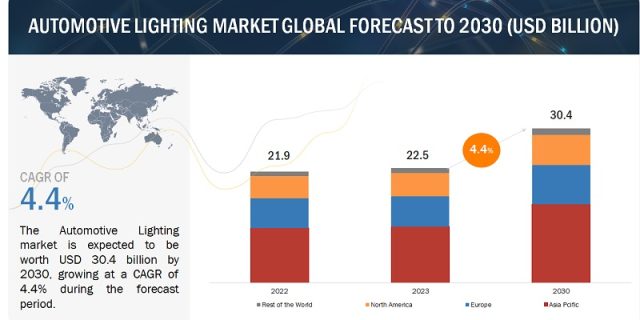
The Automotive Lighting market worldwide size was valued at USD 22.5 billion in 2023 and is expected to reach USD 30.4 billion by 2030, at a CAGR of 4.4%. Automotive Lighting is undergoing a transformative evolution driven by technological advancement, increasing safety concerns among car users, and changing consumer preferences. The market for automotive lighting has been pushed by governments’ adoption of sophisticated safety measures and the rise in demand for luxury vehicles, thereby driving the Automotive Lighting market.
Lighting Regulations for better visibility and on-road safety.
Globally, stricter lighting regulations in developed nations like Europe and North America illuminate the path for a safer future on the road. According to the World Health Organization (WHO), nearly 1.3 million lives are lost annually due to traffic accidents; governments are prioritizing improved driving conditions with advanced automotive lighting systems, which play a crucial role. Driving in heavy traffic, especially in areas with limited daylight, demands clear visibility. Here’s where regulations like the 2011 European Union mandate for daytime running lights (DRLs) come into play. These aren’t meant to increase the driver’s visibility but to make vehicles highly visible to other road users, reducing the risk of collisions. In such cases, the impact of DRLs is undeniable. According to the US National Highway Traffic Safety Administration (NHTSA), there is a reduction in fatal crashes by 13.8%. The recent legalization of adaptive lighting in the US paves the way for even greater safety advances. In a proactive move, Japan became the first country to mandate automatic headlights in 2020.
These regulations are more than just lines on paper; they’re turning roads into safer spaces for everyone. Advanced automotive lighting systems, fueled by stricter regulations, are shining a beacon of hope on a future where driving is not just about getting somewhere but about getting there safely and efficiently.
Request Free Sample Report @ https://www.marketsandmarkets.com/requestsampleNew.asp?id=1133
Advancement in Lighting Technologies
Matrix LED, OLED, laser, and adaptive lighting are new and promising technologies for automotive lighting manufacturers. OLED is an emerging solid-state lighting technology that has the potential to emit light across large surfaces. It is a niche technology still in the research and development phase. OLED is likely to be introduced in the premium segment vehicles shortly. However, the technology would require 10 to 15 years to gain a significant market share. Adaptive driving beam (ADB) systems are glare-free lighting systems that provide permanent high beams without dazzling oncoming vehicle drivers. The feature that makes the adaptive driving beam headlights stand out is that this system can adjust to the conditions and point the beam in a way that won’t produce a glare on other drivers’ windshields. With the National Highway Traffic Safety Administration’s (NHTSA) approval, automakers can install this technology in vehicles in the United States, creating a safer and more convenient future on the road. In August 2023, Valeo introduced its Premium Adaptive Driving Beam (ADB) technology, which helps maximize the light in all road conditions for improved comfort and safety, directing the beam of light only where it is needed and reducing the glare for oncoming drivers. This Premium Adaptive Driving Beam (ADB) technology is available for Passenger cars, buses, and Robo taxis. Automotive adaptive lighting is also expected to grow globally, especially in developed countries. In countries like India and China, there is a growing trend of equipping luxury vehicles with adaptive headlights. Recently, Audi announced updates to its e-tron GT Quattro electric sports car, including an improved lighting system with Matrix LED headlights and dynamic light sequencing. Other brands, such as Porsche, have its Dynamic Light System, and Lexus offers Bladescan Adaptive Headlights in their vehicles. The efficient performance of these technologies has attracted the attention of major automakers, which will create futuristic growth opportunities for the global Automotive Lighting market in the coming years.
Asia Pacific is the largest region in the Automotive Lighting market.
Asia Pacific is expected to be the most lucrative market for automotive lighting during the forecast period. Asia Pacific nations such as India and China have witnessed significant automotive production and sales growth over the past few years, mainly in the medium to premium luxury cars. According to MarketsandMarkets analysis, the passenger car production in Asia Pacific is expected to grow from ~42 million units in 2023 to ~47 million units by 2030, with India witnessing the fastest growth rate. The region has an adequate mix of economy to high-end vehicles depending upon the country’s economic condition.
Key Players
The Automotive Lighting Market is dominated by globally established players, such as Koito Manufacturing (Japan), Magnetic Marelli (Italy), Valeo (France), HELLA GmbH & Co. KGaA (Germany) and Stanley Electric (Japan).
Inquire Before Buying @ https://www.marketsandmarkets.com/Enquiry_Before_BuyingNew.asp?id=1133

